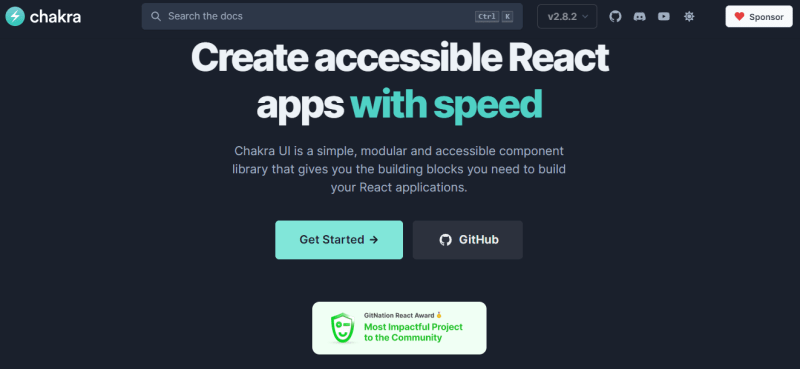Exploring 5 Top UI Frameworks for React
Introduction
Framework provides a platform where you don’t have to build everything from scratch. It saves time and also provides other features that can simplifies any one job. React has emerged as the most popular frontend framework for JavaScript which also inspires other frameworks such as NextJS. Today, we are not going to talk about the React framework but the frameworks that can be used to build the frontend.
3 years ago, I posted an article on this topic but since then I adopted and used other UI framework that I even didn’t mentioned in the article. The UI framework mentioned in that article still holds good even today, you can look into those from 4 Best UI Framework For ReactJS.
Today, we are going to some other UI frameworks. Some of them are popular and some are underrated. So, let’s get started.
1. Chakra UI
The most liked comment on my previous article was recommending I to look for Chakra UI. Since then there has been no looking back. I have adopted and used Chakra UI extensively. For me, Chakra UI has become the go-to framework for building my application.
Here are some features of Chakra UI:
Easy to Use: It is quite easy to use with a few steps to install for your framework. They have awesome documentation for a guide.
Numerous Components: It provides a lot of components that are more than necessary to build different UI components.
Customization: With a few steps you can create a customizable component as per your design that remains consistent.
2. Next UI
Next UI is a framework that is built on top of Tailwind CSS and React Aria. Next UI is not related to NextJS or vercel, it is an independent community. The design provided by NextUI is beautiful and has support for React, NextJS, Vite, Remix, and Astro.
Some features of NextUI:
Accessibility: The components provided by NextUI are accessible to all users. They adhered to accessibility standards and guidelines.
Customization and Flexibility: You can easily create theme or override initial styles.
Slots: In order to offer developers the utmost flexibility, a lot of NextUI components come equipped with slots. These slots act as designated areas within the component where developers can inject custom styles or content as per their requirements.
3. Mantine
Mantine is another React component library but it focuses on user and developer experience. They have official support for NextJS, Vite, Remix, RedwoodJS, and Gatsby. Mantine has more than 100 components with 20+ components for input. It also provides a component to build a Rick Text editor.
Here are some features of Mantine:
Charts: Along with UI, it provides serves as a charting library too. You can create beautiful starts such as Area, Bar, Line and others.
Hooks: Mantine hooks are custom functions that help with state management, DOM manipulation, and design-related tasks in the Mantine React component library.
Color Scheme: You can easily add a dark theme to you application with few lines of code. Every component has support for dark/light themes.
4. Gormmet
Gormmet focuses on building responsive web applications that use a mobile-first approach. It has support It mostly focuses on building a responsive component that is flexible to support any devices including mobile phones. It has different kind of components such as utilities that includes InfiniteScroll and Visualization such as WorldMap and DataTable.
Here are some features of Gormmet:
Mobile-first approach: If you are a fan of this approach then Gormmet is for you. It has a responsive design that can support any mobile design.
Layouts: It uses Flexbox and CSS Grid to provide a layout that can used to display content on phones and widescreen displays.
Form Validation: It has built-in form validation features. It will help you reduce the code and time that require for writing validation code.
5. Prime React
Prime React claims to to be the most complete UI Suie for ReactJS by providing a rich component set. They have components from basic such as buttons and input fields to complex components such as charts, data tables, and calendars. They have 80+ UI components and all have support for response design.
Here are some features of Prime React:
Accessibility and Internationalization: PrimeReact places a strong emphasis on accessibility and internationalization (i18n) to ensure that applications built with PrimeReact are usable and accessible to a diverse audience.
Extensive Component Library: Numerous components with a wide range of functionalities to build a modern application.
Template: They also offer templates that you can directly copy and paste into your code with little customization to add.
Conclusion
exploring the top UI frameworks for React reveals a diverse landscape catering to different development preferences and project requirements. From well-established names like PrimeReact with its extensive component library and emphasis on accessibility and internationalization, to emerging players like Chakra UI, Next UI, Mantine, and Grommet, each framework brings its own set of features and strengths to the table. Developers can choose from a variety of options based on factors such as ease of use, customization capabilities, support for accessibility standards, integration with other technologies like NextJS, and availability of pre-built templates.
Regardless of the choice, these frameworks collectively aim to streamline the frontend development process, empower developers to build modern and user-friendly interfaces, and ultimately enhance the overall user experience of web applications built with React.js.
I hope this article has helped you know some useful UI frameworks that you will gonna try in your next project. Thanks for reading the article.





